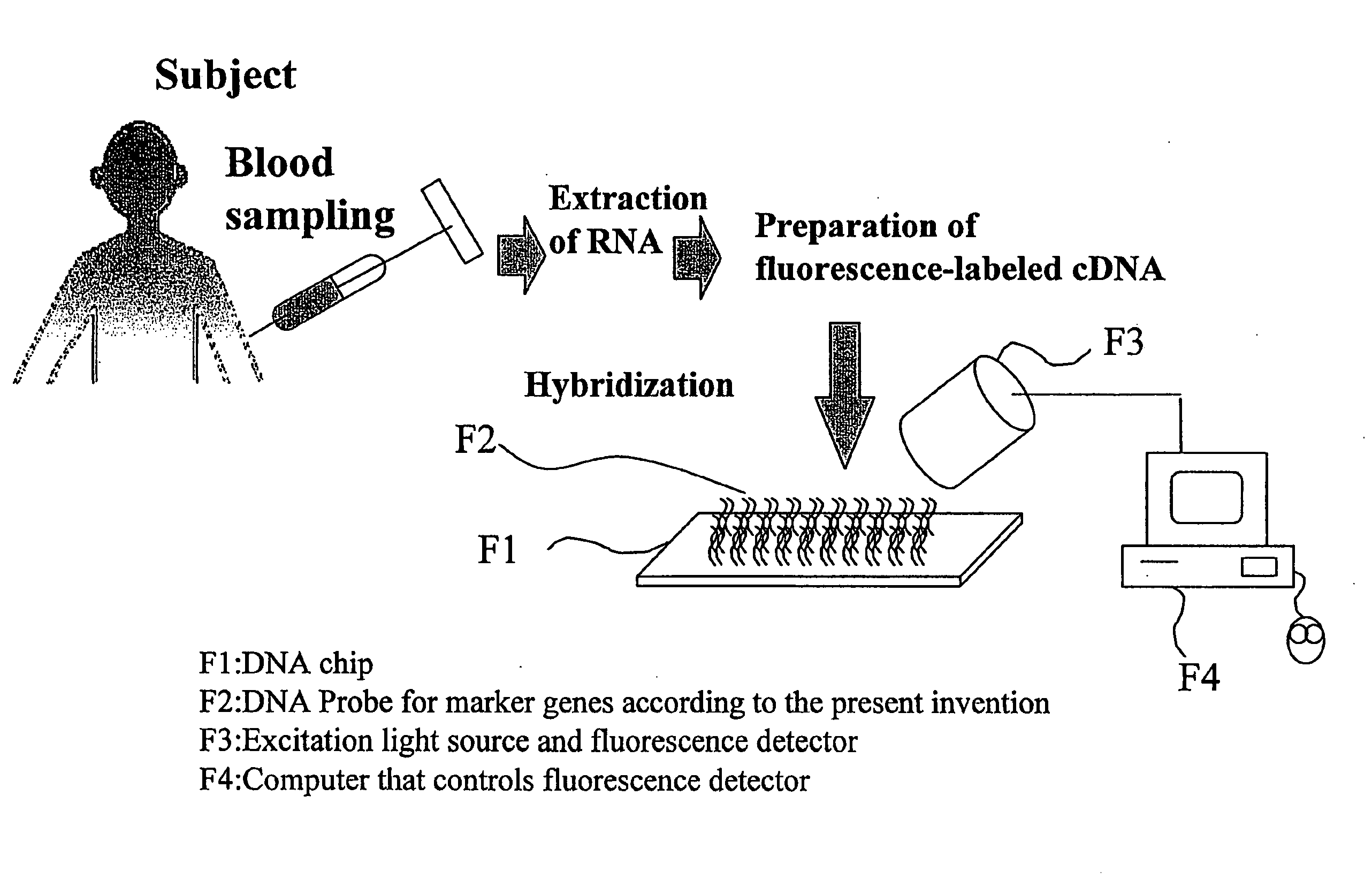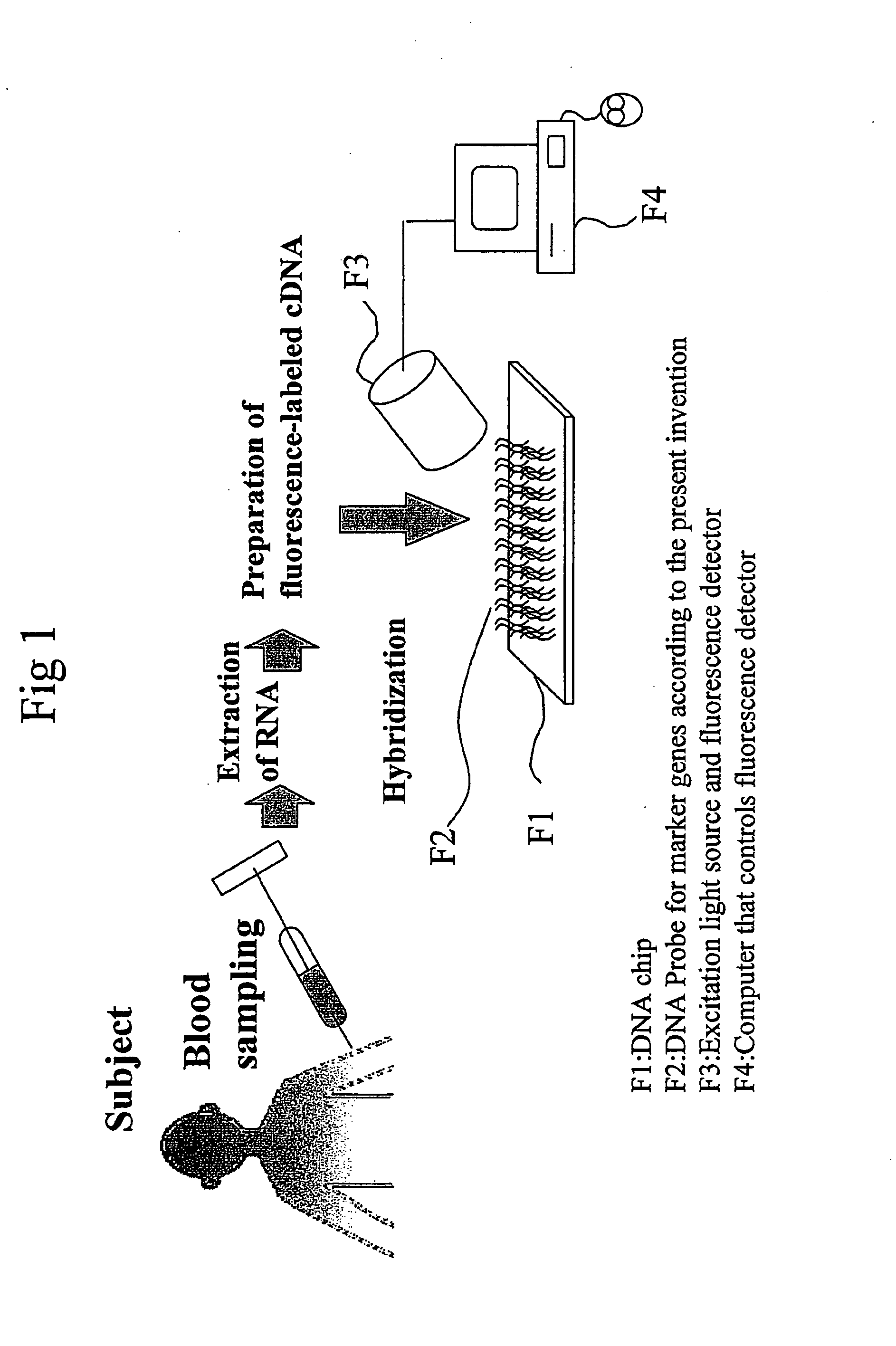Method for Diagnosing Depression
a depression and method technology, applied in the field of depression diagnosis, can solve the problems of imposing serious damage to such leukocytes, skepticism about the aforementioned reports, and difficult pathogenic gene analysis, and achieve the effect of simple and accurate method of diagnosing depression
- Summary
- Abstract
- Description
- Claims
- Application Information
AI Technical Summary
Benefits of technology
Problems solved by technology
Method used
Image
Examples
example 1
[0047]The methods for searching for and selecting the marker genes according to the present invention are described.
[0048]The present inventors collected blood from patients and healthy individuals as described below. RNA was extracted from the whole blood, and gene expression of patients was then analyzed using DNA chips, along with that of healthy individuals. A DNA chip comprises DNA fragments having nucleotide sequences corresponding to numerous genes immobilized on a substrate such as a glass substrate, and it is used for detecting DNA or RNA in a sample by hybridization.
[0049]Target patients were as follows. Target patients were those who had agreed with the written description for participating in the research for developing the present diagnostic method selected from among untreated patients afflicted with depression who had visited the Department of Psychiatry and Neurology of the Tokushima University Hospital between November 2002 and December 2006. This research was appro...
example 2
[0057]Erythrocytes do not contain nuclei. Thus, most RNAs in the whole blood samples are considered to originate from leukocytes. Leukocytes consist of monocytes, granulocytes, and lymphocytes, and, for example, T cells, B cells, and NK cells are also lymphocytes. Accordingly, the whole blood samples used in this test contain RNAs derived from a numerous different kinds of cells. Thus, the gene expression levels examined in this test are the result of multiplying the gene expression levels in each type of cells by the number of the cell. If the numbers of specific types of cells in the blood are different between patients and healthy individuals, accordingly, a significant difference would be observed in the expression levels of genes exhibiting specifically high expression levels in the cells. The differences in expression levels of such genes result from differences in the number of the cells; in other words, the differences in gene expression levels would be substantially uniform...
example 3
[0061]Among the 631 depression-associated genes described in Example 1, the group of genes that should be focused in order to effectively diagnose depression was examined. Genes were selected from among the 631 genes in ascending order of p values, the mean expression levels thereof were calculated, and the determined mean was subjected to a significant difference test between the group of 122 healthy individuals and the group of 46 patients to inspect the resulting p values. Specifically, a significant difference test was carried out using the mean Log value among genes for the ratio of the expression levels of patients' genes to the expression levels of healthy individuals' genes. FIG. 3 shows the results thereof. As the number of target genes for determining the mean used for diagnosis increases, the resulting p values (obtained by the intergroup test using the mean) decrease. If genes exhibiting large p values (the value obtained from only one gene) are targeted, however, the re...
PUM
| Property | Measurement | Unit |
|---|---|---|
| Ratio | aaaaa | aaaaa |
| Level | aaaaa | aaaaa |
| Threshold limit | aaaaa | aaaaa |
Abstract
Description
Claims
Application Information
 Login to View More
Login to View More - R&D Engineer
- R&D Manager
- IP Professional
- Industry Leading Data Capabilities
- Powerful AI technology
- Patent DNA Extraction
Browse by: Latest US Patents, China's latest patents, Technical Efficacy Thesaurus, Application Domain, Technology Topic, Popular Technical Reports.
© 2024 PatSnap. All rights reserved.Legal|Privacy policy|Modern Slavery Act Transparency Statement|Sitemap|About US| Contact US: help@patsnap.com










